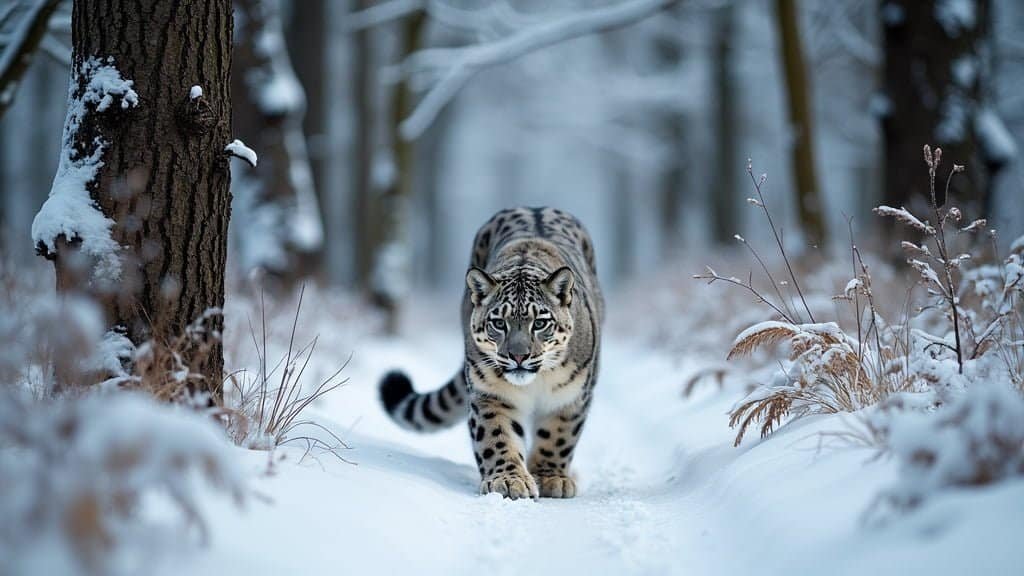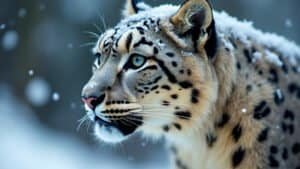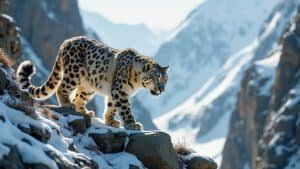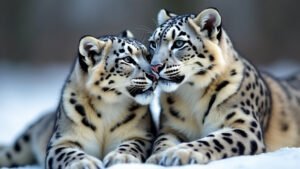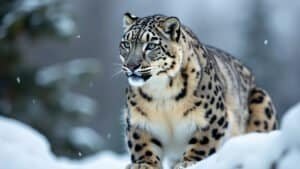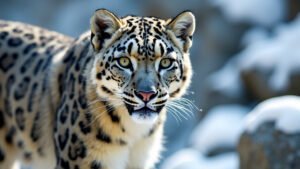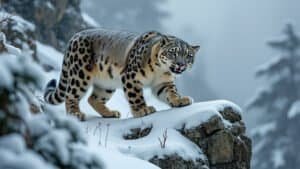Introduction
The snow leopard is a marvel of evolutionary adaptation, perfectly suited to survive in the harsh, mountainous regions of Central and South Asia. This elusive predator has developed a range of unique traits that allow it to thrive in environments where few others can
In this article, we will explore the key evolutionary pressures that have shaped the snow leopard’s physical and behavioral adaptations. From its specialized diet and hunting techniques to its solitary lifestyle and reproductive strategies, each aspect of the snow leopard’s biology tells a story of survival in one of the planet’s most challenging habitats
Habitat and Environmental Influence
The snow leopard’s adaptations are deeply rooted in the rugged and inhospitable terrain it calls home. These big cats are native to the mountainous regions of Central and South Asia, including the Himalayas, the Tibetan Plateau, and parts of Mongolia and Russia
This harsh environment, characterized by steep cliffs, deep gorges, and altitudes ranging from 9,800 to 16,400 feet, presents a unique set of challenges that have shaped the snow leopard’s evolution over millennia
Adaptations to Altitude and Terrain
Living at such high altitudes, where oxygen levels are significantly lower, has led the snow leopard to develop several physiological adaptations. One of the most notable is its enlarged nasal cavities, which allow for more efficient oxygen intake
This adaptation is crucial for surviving in thin air, where oxygen levels can be up to 40% lower than at sea level. Additionally, the snow leopard has a strong, muscular diaphragm that aids in respiration, allowing it to maintain the energy levels needed for hunting and navigating the rugged terrain
The snow leopard’s powerful hind legs are another critical adaptation, enabling it to leap up to 50 feet horizontally and 20 feet vertically. This ability is essential for traversing the steep, rocky cliffs of its habitat, where it often has to leap across gaps and climb steep slopes
The large, fur-covered paws act like snowshoes, distributing the animal’s weight evenly across the snow and providing traction on slippery surfaces. This adaptation is vital for stalking prey in snowy conditions without sinking or slipping
Impact of Extreme Cold on Physical Traits
The extreme cold of the snow leopard’s environment has driven the evolution of several physical traits that help it conserve heat and survive freezing temperatures. Its thick, dense fur, which can grow up to five inches long on the belly, provides excellent insulation against the cold
This fur is not only thick but also has a unique texture, with long guard hairs protecting a dense undercoat, trapping warm air close to the body
The snow leopard’s tail, which can be as long as its body, also plays a crucial role in thermoregulation. The tail is covered in thick fur and is often wrapped around the animal’s body when resting, providing additional warmth
This tail also serves as a balancing tool, helping the snow leopard navigate the treacherous terrain of its habitat with precision and stability
Role of Solitary Behavior in Survival
The snow leopard’s solitary nature is another adaptation shaped by its environment. The sparse distribution of prey in its mountainous habitat means that these cats must cover large territories to find enough food
As a result, snow leopards are highly territorial and tend to avoid each other except during mating season. This solitary behavior reduces competition for resources, ensuring that each individual has access to sufficient prey to survive
The snow leopard’s elusive nature, combined with its camouflage, makes it an expert in stealth. Its pale gray coat, covered in rosettes and spots, blends seamlessly with the rocky, snow-covered landscape, allowing it to approach prey undetected
This camouflage is crucial for a predator that relies on the element of surprise to hunt in such challenging terrain
Dietary and Hunting Adaptations
The snow leopard’s diet and hunting strategies are intricately linked to its harsh environment, where food sources are scarce and difficult to capture
Over time, this big cat has evolved a variety of adaptations that enable it to hunt efficiently and survive on the limited prey available in its mountainous habitat
Evolution of Prey Preferences
Snow leopards are opportunistic predators, primarily preying on species that are well-adapted to their high-altitude environment. Their diet mainly consists of blue sheep (bharal), Siberian ibex, and Himalayan tahr, which are all agile mountain ungulates
These prey animals are not only challenging to catch due to their speed and agility, but they are also sparsely distributed across the snow leopard’s vast territory. As a result, snow leopards have evolved to become highly skilled hunters capable of taking down prey that can weigh up to three times their own body weight
In addition to large ungulates, snow leopards will also hunt smaller animals such as marmots, pikas, and birds when larger prey is scarce. This dietary flexibility is crucial for survival in an environment where food availability can fluctuate dramatically with the seasons and the harshness of the winter
During times of scarcity, snow leopards may also scavenge on carrion or even venture closer to human settlements to prey on livestock, a behavior that unfortunately brings them into conflict with humans
Hunting Techniques for Mountainous Areas
The snow leopard’s hunting techniques have evolved to match the challenges of its mountainous environment. Unlike other big cats that rely on speed to chase down prey, snow leopards use their stealth and ambush tactics to get as close as possible to their target before launching a surprise attack
Their powerful hind legs, capable of propelling them great distances in a single leap, are essential for this ambush strategy, allowing them to pounce on prey with precision
The terrain also plays a significant role in the snow leopard’s hunting success. These cats often use the rocky outcrops and cliffs to their advantage, positioning themselves above their prey and attacking from above, where the steep slopes limit the prey’s ability to escape
This strategy not only increases the likelihood of a successful kill but also minimizes the energy expenditure required to chase down prey across the rugged landscape
Another key adaptation is the snow leopard’s ability to hunt at any time of day or night, though they are most active during dawn and dusk
Their keen eyesight and acute hearing are perfectly adapted to the low-light conditions of their environment, enabling them to detect even the slightest movements of potential prey
Influence of Competition on Feeding Strategies
In the remote and sparsely populated regions where snow leopards live, competition for food can be intense, especially with other predators like wolves and lynxes. However, the snow leopard has developed strategies to minimize direct competition and maximize its feeding efficiency
One such strategy is its solitary hunting behavior, which reduces the likelihood of encountering other predators while searching for food
Additionally, snow leopards have evolved to consume a wide range of prey, from large ungulates to small mammals, which helps them avoid direct competition with other predators that may specialize in a narrower diet
This dietary flexibility not only increases their chances of finding food but also allows them to occupy a unique ecological niche within their environment
Finally, snow leopards often cache their kills in secluded spots, such as rocky crevices or under overhanging cliffs, to protect them from scavengers and other predators
This behavior allows them to return to a kill over several days, reducing the frequency with which they need to hunt and conserving their energy for when it is most needed
Reproductive and Social Behavior
The reproductive strategies and social behaviors of snow leopards are closely tied to the challenges posed by their harsh, isolated environments
These adaptations ensure the survival of their species despite the many difficulties they face, such as low prey density, extreme weather, and limited opportunities for mating
Evolution of Mating Strategies
Snow leopards have developed specific mating strategies to cope with their solitary lifestyles and vast territories. Unlike other big cats, snow leopards do not form permanent pair bonds
Instead, they come together only during the breeding season, which typically occurs between January and March. This timing is critical, as it ensures that cubs are born in the spring or early summer when conditions are less severe and prey is more abundant, increasing the chances of survival
During the breeding season, male snow leopards may travel long distances, crossing the territories of other males, in search of a receptive female. This behavior increases genetic diversity within the population but also heightens the risk of conflict between males
To attract a mate, both males and females engage in vocalizations and scent marking. The snow leopard’s call, a loud, moaning roar, can carry across the vast mountain landscape, helping individuals find each other in the rugged terrain
After mating, the male typically leaves, and the female takes on the sole responsibility of raising the cubs. The gestation period lasts about 90-100 days, resulting in the birth of one to three cubs
The small litter size is another adaptation to the environment, as the limited resources and harsh conditions make it difficult for a female to support more than a few offspring
Parental Care and Survival Rates
Snow leopard mothers are highly protective and nurturing, investing significant time and energy into raising their young. Cubs are born blind and helpless, relying entirely on their mother for warmth, nourishment, and protection
The mother provides the cubs with a safe den, usually a secluded rock crevice or cave, where they remain hidden from potential predators for the first few weeks of life
The cubs are weaned at around two to three months of age but continue to depend on their mother for food and survival skills until they are about 18-22 months old. During this time, the mother teaches her cubs essential hunting and survival techniques, such as how to stalk prey, navigate the treacherous terrain, and avoid danger
Despite this intensive care, the survival rate of snow leopard cubs is relatively low. The harsh conditions, scarcity of prey, and risks from other predators all contribute to the challenges of rearing young in such an unforgiving environment
Those cubs that do survive to independence must then establish their own territories, often traveling long distances to find an area with sufficient resources
Genetic Diversity and Population Health
Genetic diversity is a critical factor in the long-term survival of any species, including snow leopards. However, the isolated and fragmented nature of snow leopard populations poses a significant challenge to maintaining genetic diversity
With small, scattered populations across vast and often disconnected mountain ranges, inbreeding becomes a concern, which can lead to reduced genetic health and increased vulnerability to diseases
Conservation efforts are increasingly focused on preserving genetic diversity within snow leopard populations. Initiatives such as wildlife corridors, which connect isolated populations, and anti-poaching measures are vital in maintaining the health and viability of these populations
Research has shown that while snow leopards have a relatively low genetic diversity compared to other big cats, they possess unique genetic traits that have allowed them to adapt to their extreme environment, such as genes related to high-altitude survival and energy metabolism
In recent years, advancements in genetic research and technology have provided valuable insights into the snow leopard’s genetic makeup, helping conservationists develop more effective strategies to protect this iconic species
These efforts aim not only to preserve the existing populations but also to ensure that snow leopards can continue to adapt and thrive in their changing environment
Conclusion
The snow leopard is a remarkable example of evolutionary adaptation, shaped by the extreme pressures of its mountainous environment. From its physiological traits like thick fur and powerful legs to its behavioral strategies such as solitary hunting and careful parental care, every aspect of the snow leopard’s biology is fine-tuned for survival in one of the most challenging habitats on Earth
The harsh climate, scarce prey, and isolated terrain have driven the evolution of unique adaptations that allow the snow leopard to thrive where few others can. However, these same pressures make the species vulnerable to environmental changes and human impact, highlighting the importance of ongoing conservation efforts
Understanding the evolutionary pressures that have shaped the snow leopard not only deepens our appreciation for this elusive predator but also underscores the need to protect its fragile ecosystem for future generations
